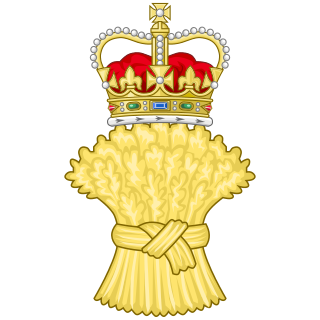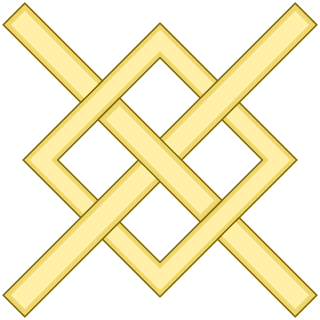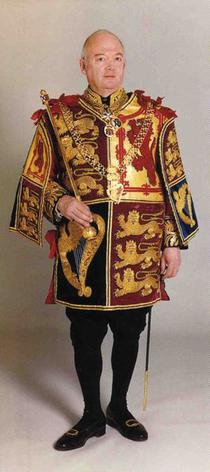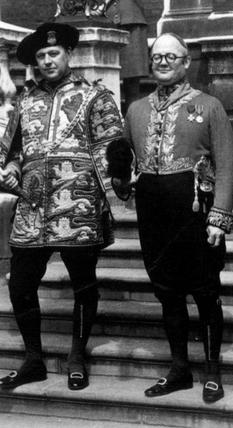
The College of Arms, or Heralds' College, is a royal corporation consisting of professional officers of arms, with jurisdiction over England, Wales, Northern Ireland and some Commonwealth realms. The heralds are appointed by the British Sovereign and are delegated authority to act on behalf of the Crown in all matters of heraldry, the granting of new coats of arms, genealogical research and the recording of pedigrees. The College is also the official body responsible for matters relating to the flying of flags on land, and it maintains the official registers of flags and other national symbols. Though a part of the Royal Household of the United Kingdom, the College is self-financed, unsupported by any public funds.

Sir Albert William Woods was an English officer of arms, who served as Garter Principal King of Arms from 1869 to 1904. The Woods family has a strong tradition of service at the College of Arms. Albert Woods was the son of Sir William Woods, Garter King of Arms from 1838 until his death in 1842. Likewise, the grandson of Albert Woods was Sir Gerald Woods Wollaston, who also rose to the rank of Garter King of Arms and served there from 1930 until 1944.

New Zealand Herald of Arms Extraordinary is an officer of arms representing the heraldic interests of New Zealand. Although affiliated with the College of Arms in London, the New Zealand Herald lives and works in New Zealand, and is not a member of the College Chapter. Since the New Zealand Herald was appointed, there have been questions as to his legitimacy and whether, as working under the authority of the College of Arms, he has any legal authority to regulate heraldry in New Zealand. The current New Zealand Herald of Arms Extraordinary is Phillip O'Shea.

Norroy and Ulster King of Arms is the provincial King of Arms at the College of Arms with jurisdiction over England north of the Trent and Northern Ireland. The two offices of Norroy and Ulster were formerly separate. Norroy King of Arms is the older office, there being a reference as early as 1276 to a "King of Heralds beyond the Trent in the North". The name Norroy is derived from the Old French nort roy meaning 'north king'. The office of Ulster Principal King of Arms for All-Ireland was established in 1552 by King Edward VI to replace the older post of Ireland King of Arms, which had lapsed in 1487.

Chester Herald of Arms in Ordinary is an officer of arms at the College of Arms in London. The office of Chester Herald dates from the 14th century, and it is reputed that the holder was herald to Edward, Prince of Wales, also known as the Black Prince. In the reign of King Richard II the officer was attached to the Principality of Chester, which was a perquisite of the then Prince of Wales. In the reign of King Henry VIII the title lapsed for a time but, since 1525, the office of Chester has been one of unbroken succession, as a herald in ordinary. The badge of office is taken from the arms of the Earl of Chester and in blazoned as A Garb ensigned of the Royal Crown Or.

Somerset Herald of Arms in Ordinary is an officer of arms at the College of Arms in London. In the year 1448 Somerset Herald is known to have served the Duke of Somerset, but by the time of the coronation of King Henry VII in 1485 his successor appears to have been raised to the rank of a royal officer, when he was the only herald to receive coronation liveries.

Arundel Herald of Arms Extraordinary is a supernumerary Officer of Arms in England. Though a royal herald, Arundel is not a member of the College of Arms, and was originally a private herald in the household of Thomas Fitzalan, Earl of Arundel. The first herald, John Cosoun, is known to have served the Earl both in Portugal in 1413 and later in France, where he attended his dying master in October 1415. The title was revived in 1727 as Herald Extraordinary.

Beaumont Herald of Arms Extraordinary was an officer of arms extraordinary in England. Beaumont was a royal herald, but was not a member of the College of Arms. The office was created in 1982 and named after the barony of Beaumont, one of the subsidiary titles of the Earl Marshal, the Duke of Norfolk. The badge of office combines the cross potent of the Kings of Jerusalem from whom the Beaumonts are descended, with the lion and fleur-de-lis charges from the family coat of arms. It is blazoned In front of a Cross Potent a Lion rampant within eight Fleurs-de-lis in orle Or.

Maltravers Herald of Arms Extraordinary is a current officer of arms extraordinary in England. As such, Maltravers is a royal herald, but is not a member of the College of Arms in London. The present office was created in 1887 by the Earl Marshal, who was also the Duke of Norfolk and Baron Maltravers. The office is known to have been held by a pursuivant to Lord Maltravers when he was deputy of Calais from 1540 to 1544. The badge is blazoned as A Fret Or. It was officially assigned in 1973, though it had been assumed by two Maltravers Heralds in the 1930s. It derives from the coat of arms of Maltravers Sable a Fret Or and a Label of the points Ermine, and was the badge of John, Earl of Arundel through which family the barony passed to the Howard dukes of Norfolk.

Norfolk Herald of Arms Extraordinary is an officer of arms in England. As an officer extraordinary, Norfolk is a royal herald, though not a member of the corporation of the College of Arms in London. Beginning in 1539 this officer was a herald to the dukes of Norfolk, though the first holder, John James, was paid a salary by King Henry VIII. Subsequent Norfolk heralds have been officers extraordinary, though the office has not always been filled but rather revived when required. The badge of office, assigned in 1958, is blazoned as Two Ostrich Feathers saltirewise each charged with a Gold Chain laid along the quill. It derives from the ostrich feather badge granted by King Richard II around 1387 as a mark of special favor to Thomas Mowbray, Duke of Norfolk, Marshal of England. Mowbray was also the first to be styled Earl Marshal.

Fitzalan Pursuivant of Arms Extraordinary is a current officer of arms in England. As a pursuivant extraordinary, Fitzalan is a royal officer of arms, but is not a member of the corporation of the College of Arms in London. As with many other extraordinary offices of arms, Fitzalan Pursuivant obtains its title from one of the baronies held by the Duke of Norfolk, Earl Marshal of England; the appointment was first made for the coronation of Queen Victoria in 1837. The badge of office was assigned in 1958 and is derived from a Fitzalan badge of the fifteenth century. It can be blazoned An Oak Sprig Vert Acorns Or, but is also recorded as A Sprig of Oak proper.

John Philip Brooke Brooke-Little was an English writer on heraldic subjects, and a long-serving herald at the College of Arms in London. In 1947, while still a student, Brooke-Little founded the Society of Heraldic Antiquaries, now known as the Heraldry Society and recognised as one of the leading learned societies in its field. He served as the society's chairman for 50 years and then as its president from 1997 until his death in 2006.

Sir Alexander Colin Cole was a long serving officer of arms at the College of Arms in London. Eventually, he would rise to the rank of Garter Principal King of Arms, the highest heraldic office in England and Wales.
Sir Walter John George Verco was a long-serving officer of arms who served in many capacities at the College of Arms in London.
Charles WilfridScott-Giles was an English writer on heraldry and an officer of arms, who served as Fitzalan Pursuivant Extraordinary.

Surrey Herald of Arms Extraordinary was an English officer of arms. Though an officer of the crown, Surrey Herald Extraordinary was not a member of the corporation of the College of Arms in London. This office was created in 1856 and first held by Edward Stephen Dendy. The badge of office was assigned in 1981. The badge is blazoned Within a representation of a Herald's Collar of SS Argent a Tabard chequy Or and Azure. These were the arms of John de Warenne, Earl of Surrey in the late thirteenth century, from whom the earldom descended through the Fitzalans to the Howard dukes of Norfolk and earls marshal.

David Hubert Boothby Chesshyre was a British officer of arms.

The Cross of Neith was a sacred relic believed to be a fragment of the True Cross that had been kept at Aberconwy by the kings and princes of Gwynedd, members of the Aberffraw dynasty who established the Principality of Wales. They believed it afforded them and their people divine protection. It is not known when it had arrived in Gwynedd or how they had inherited it, but it is possible that it was brought back from Rome by King Hywel Dda following his pilgrimage in about 928. According to tradition it was handed down from prince to prince until the time of Llywelyn ap Gruffudd and his brother Dafydd. A representation of the cross came to be used as a Battle Flag.
Mowbray Herald of Arms Extraordinary was an English officer of arms. From the time of King Richard II to that of Henry VI, Mowbray was the Duke of Norfolk's private herald. Since its revival in 1623 the title has always been given to a herald extraordinary. Though an officer of the crown, Mowbray Herald Extraordinary was not a member of the corporation of the College of Arms in London. Sir William le Neve appears to have been appointed to the office from 29 June 1624 until his appointment as York Herald the following year. The office was recreated in January 1695 for Robert Plot, who was made Registrar of the College of Heralds just two days later and was subsequently held by Joseph Edmondson.

Howard Pursuivant of Arms Extraordinary was an officer of arms extraordinary in England; that is, a royal herald but not a member of the College of Arms in London.





















